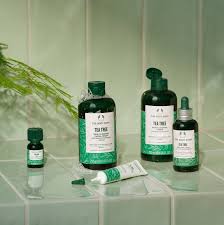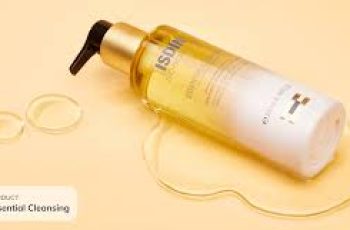
Tea tree oil in skin care
Tea tree oil is one of the best natural antimicrobial ingredients in skin care.
It has been used for cosmetic purposes for thousands of years and remains popular today.
The only significant drawback of tea tree oil is its potential as an allergen.
To find out if tea tree oil is right for your skin, take the Baumann Skin Type questionnaire!
Take the Quiz
Table of contents
What is tea tree oil
Tea tree oil (TTO) is a plant oil derived from the melaleuca alternifolia bush found in and around Australia.
TTO has been used for thousands of years by native Australians for traditional medical purposes like treating bruises, respiratory issues, and skin infections.(10)
Today, TTO can still be found in many skin care products, and is considered especially good for use in acne products. (4,11,15)
Multiple studies have found TTO to be one of the most effective broad spectrum antimicrobial ingredients on the market. (3,12,14)
Tea tree uses
Uses for skin
Tea tree oil can be found in many kinds of skin care products designed to treat conditions like.(8,18,45)
Acne
Burns (including sunburns)
Cold sores
Cuts and wounds
Fungal infections
Hair care
Inflammation
Lice
Psoriasis
Rash
Tinea
TTO is usually used in low concentrations in skin care products because it is extremely potent.
TTO is typically used in cosmetics for its extremely significant antimicrobial properties. (12)
It can also be found in many laundry detergents as it eliminates mites. (6)
Benefits of tea tree oil
Tea tree oil is one of the best, if not the best, antimicrobial plant oils used in skin care.
Its beneficial activities include:
Anti bacterial
Anti fungal
Anti-inflammatory
Antioxidants
Anti viral
Anti-microbial
Tea tree oil is particularly effective as an antimicrobial ingredient in skin care. (2,5)
A 2001 study revealed that TTO blocks the conversion of certain kinds of yeast into their pathogenic forms. (2)
These findings lead the researchers to claim that TTO could be a suitable ingredient in the treatment of various fungal infections.
Another study found that TTO might be effective in combatting swimmers ear as well, however, there is a chance of resulting damage to the ear. (23)
In 2008, another case reported success in treating warts caused by HPV (Human Papillomavirus) over 12 days. (24)
Studies have also found that repeated use of TTO does not result in the development of more resistant skin bacteria or fungi. (18)
TTO is 13 times more antiseptic, or disinfectant, than carbolic acid (another common antiseptic). (12,13)
Some studies even suggest that TTO might be effective in eliminating some varieties of the herpes virus. (44)
Skin cancer
Multiple studies have been conducted on the efficacy of tea tree oil in cancer treatments, and many have found success in use of the ingredient.
For example, in 2012, one study reported that a 10% dilution of TTO in certain formulations quickly resulted in anti-cancer effects in tumors under the skin. (20)
Another study also found anti-tumor benefits through topical application of TTO. (21)
The science supporting TTO in cancer treatments is extremely promising and exciting. More research is needed to determine what other kinds of cancers TTO might treat.
However, skin cancers can be deadly. Do not try to treat them yourself. We recommend seeing a dermatologist if you have any suspicious lesions.
Tea tree for acne
For acne
Tea tree oil is a good ingredient for use in acne regimens because it is a very potent antimicrobial ingredient that does not clog pores.
When compared in a study to benzol peroxide, one of the most common acne treating ingredients, it was found that while benzol peroxide worked faster than TTO, TTO had fewer side-effects. (3)
Tea tree oil work best when combined with other acne treatments such as salicylic acid and retinoids.
If tea tree oil is used as the soul agent to treat acne, topical application of TTO is recommended three or four times daily. (14)
For dry skin conditions
Tea tree oil contains no fatty acids, which means it serves no function in moisturizing skin or repairing the skin barrier.
That being said, as it contains anti-inflammatory properties, it can still have uses as an ingredient in dry skin products but should be combined with a barrier repair moisturizer and a barrier protecting cleanser.
When used alongside a moisturizing ingredient like sunflower oil, TTO might have a place in dry skin regimens, depending which of the 16 Baumann Skin Types you are.
Eczema
Because it does not hydrate the skin on its own, or repair the barrier, it’s use in eczema treatments is limited to its antimicrobial properties to help decrease the skin infections seen in eczema.
When combined with barrier repair moisturizers and hydrating oils such as argan oil, evening primrose oil, and jojoba oil, tea tree oil may be effective for eczema.
Psoriasis
Psoriasis is a chronic inflammatory skin disease that is characterized by the hyperproliferation of keratinocytes and inflammation.
Terpinen-4-ol is a naturally occurring terpene alcohol found in the essential oil of Melaleuca alternifolia (tea tree oil).
There is currently limited research specifically on the mechanism by which terpinen-4-ol may work for psoriasis, but it is likely that the antimicrobial and anti-inflammatory properties of terpinen-4-ol help reduce the severity of psoriasis symptoms.(16)
Additionally, terpinen-4-ol has been found to have antioxidant properties, which may help protect the skin from oxidative stress, a potential trigger for psoriasis.
However, more research is needed to fully understand the mechanism by which terpinen-4-ol may work for psoriasis and to determine its effectiveness and safety for this purpose.
tea tree for sensitive skin
For sensitive skin
TTO is also effective in the treatment of many kinds of rashes, rosacea, and other types of skin inflammation.
Skin Inflammation
Tea tree oil contains several chemical components that have been shown to have anti-inflammatory properties, including terpinen-4-ol, alpha-pinene, and gamma-terpinene.
Terpinen-4-ol is one of the main components of tea tree oil and has been extensively studied for its anti-inflammatory properties.
It has been shown to inhibit the production of pro-inflammatory cytokines and chemokines, which are molecules that play a key role in the inflammatory response.
Terpinen-4-ol has also been found to suppress the activation of nuclear factor-kappa B (NF-kB), a transcription factor that regulates the expression of genes involved in inflammation.
Alpha-pinene and gamma-terpinene are also present in tea tree oil and have been shown to have anti-inflammatory properties.
Alpha-pinene has been found to inhibit the production of pro-inflammatory cytokines and chemokines, while gamma-terpinene has been shown to inhibit the production of the pro-inflammatory enzyme cyclooxygenase-2 (COX-2).
The anti-inflammatory properties of these chemical components in tea tree oil may help to reduce inflammation and swelling in the skin, however, it is important to note that tea tree oil should be used with caution, as it can cause skin irritation and allergic reactions in some individuals.
Rosacea
Inflammation also plays a role in rosacea.
One study (48) in 2017 evaluated the efficacy of a topical combination of tea tree oil and metronidazole in treating rosacea. The study found that the combination treatment was more effective in reducing the severity of rosacea symptoms compared to metronidazole alone.
Demodex mites play a role in rosacea and the eye inflammation called blepharitis that afflicts some people with rosacea.
One study (51) found that tea tree oil was effective in killing Demodex mites and the study authors suggest that tea tree oil may be a useful topical treatment option for patients with Demodex-associated conditions.
Overall, these studies suggest that tea tree oil may have potential benefits for individuals with rosacea, including its anti-inflammatory and anti-microbial properties.
More research is needed to determine the most effective formulation and dosage to treat rosacea.
What kind of oil is tea tree?
Tea tree oil is mostly composed of terpenes, which means it is an essential oil without any lipid content.
In other words, tea tree oil is not a true oil.
As a pressed plant extract, tea tree oil is often considered an essential oil, it carries a strong, desirable fragrance.
It is usually processed with chemicals, so is not organic like many other essential oils are.
Active compounds?
Tea tree oil contains more than 100 active chemical compounds, primarily terpenes and alcohols.
The most significant active compounds in tea tree oil are (5,6):
Terpinen-4-ol
γ-terpinene
α-terpinene
α-terpineol
α-pinene
Cineole
Terpinolene
Terpinen-4-ol is a very common allergen*
side-effects of tea tree
Side effects
Even though tea tree oil has so many benefits, there have been a few observed side-effects as well.
TTO should not be consumed orally, as it is considered toxic.
Common side-effects from orally consuming TTO can include (6,10,17):
Confusion
Coma
Diarrhea
Drowsiness
Hallucinations
Nausea
Vomiting
Weakness
A recent study conducted in Italy on the use of plant-based products in skin care found that 11% of people studied had some kind of negative allergic reaction to TTO. (33)
The most significant active compound in TTO, terpinen-4-ol, is an extremely common allergen. (34)
If you are allergic to tea tree oil, repeated use can result in worsening reactions over time.
Be sure to check ingredient labels for your known allergens!
Is tea tree oil safe?
Unless you are allergic to or orally consuming tea tree oil, it is considered safe.
The EWG rating for tea tree oil is a “6,” which is fairly poor, however that safety rating primarily reflects how common an allergen it is and the aforementioned toxicity when consumed orally.
Otherwise, the risks of TTO have been demonstrated as minimal in many studies, and it is used in many skin care products today.
To make sure tea tree oil products are safe for your skin care, shop by your Baumann Skin Type.
Tea tree oil is also a sustainable resource, it can be harvested year round and recover quickly from harvesting.
Take the Quiz
how to use tea tree oil
How to use tea tree oil
The exact procedure for applying your tea tree oil products will depend on your personal skin concerns and custom skin care regimen.
Tea tree oil is primarily used in cleansers and bacteria eliminating products as it is an extremely effective antimicrobial ingredient.
It can be applied up to three times a day during normal acne routines if it is a part of your custom skin care regimen.
When applying to hair for everyday use, be sure to use a very small amount.
Tea tree oil is best used very modestly, and run through the sides of your hair instead of on your roots. Overuse will result in greasy looking and feeling hair.
When found in high concentrations such as in spot treatments, TTO is best only applied directly to pimples, not the whole face.
Coconut oil vs tea tree for skin care
Coconut oil and tea tree oil serve completely different functions in skin care.
Coconut oil is composed of hydrating and barrier forming fatty acids which make it a great ingredient in moisturizers.
Tea tree oil has no lipid content, so instead is used for it’s antimicrobial benefits.
Differences for hair care
Coconut oil and tea tree oil are two of the most popular oils used in hair care, so it might be easy to assume they share many traits in common; however, their functions in hair care are very different.
Coconut oil is primarily composed of solidifying, creamy, saturated fats which are good at locking moisture into the hair but can weigh down waves and curls.
Some unsaturated fats are present in coconut oil which hydrate the scalp, follicles, and hair strands, but the oil is comedogenic if in its more common, unrefined form.
Coconut oil is great for protecting your hair from all sorts of environmental factors like sun, humidity, and wind, but becomes solid and unpleasant in cold weather.
Tea tree oil on the other hand is composed primarily of terpenes which are not lipids.
The antimicrobial compounds and fatty alcohols in tea tree oil serve dual purposes in hair care; preventing/eliminating dermatophytes and hydrating the scalp.
In other words, tea tree oil is used to keep hair clean, and prevent dryness.
Tea tree oil in hair care
Tea tree oil has many antimicrobial functions in hair care products.
TTO has been shown to treat and prevent dandruff when used at as little as a 5% concentration in shampoos. One study reported a 41% improvement in dandruff following repeated use of TTO.(26,27)
Another study conducted that same year showed TTO to be an effective treatment for various dermatophytes (fungal buildups or infections on the hair, nails, or skin).(28)
TTO has the ability to prevent, suffocate, an otherwise eliminate pests like headlice or ticks. It is more effective at eliminating these pests than other popular chemicals like pyrethrins. (29)
There are even uses for tea tree oil in hair loss products, with one study finding that hair growth, strand count, and thickness of hair all increased after prolonged use of TTO. (31)
It is non-comedogenic so it does not pose a risk to clogging the pores on your scalp or hairline.
What kinds of products?
Tea tree oil can be found commonly in products designed to eliminate bacteria, viruses, or fungi on the skin.
Cleansers, acne spot treatments, and dandruff shampoos all often use TTO. (6)
Not all products use TTO, however, since it is such a common allergen. If you are allergic to TTO, be sure to check the ingredient label of skin care products before buying them.
Best products containing tea tree oil:
If you are not allergic to tea tree oil, it can be a very significant part of any skin care regimen, but to be sure it’s right for you, take the Baumann Skin Type questionnaire to shop by your personal skin type.


